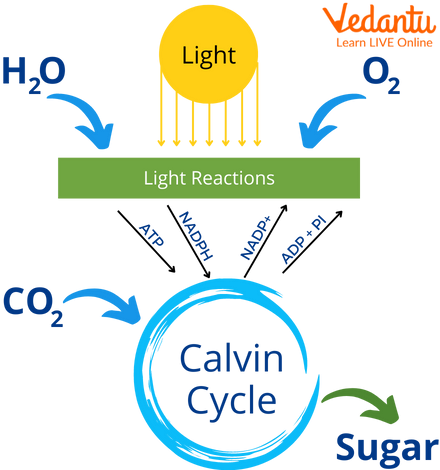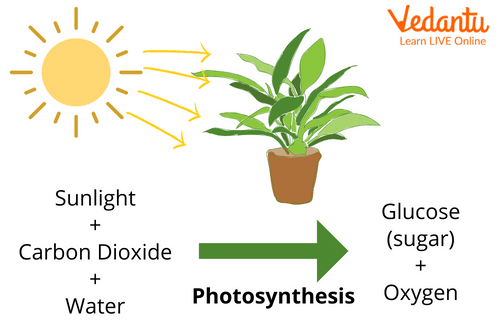




What is Photosynthesis?
Have you ever wondered where plants get food? Well, it is through the process of photosynthesis. So, what is photosynthesis? Let’s find out! Due to the fact that sunlight is energy, photosynthesis is the process through which plants convert carbon dioxide and water into food. Plant cells contain elements called chloroplasts. These structures serve as homes for the chlorophyll. The terms "photo" and "synthesis" combine to form the phrase "photosynthesis." Light is referred to as "photo" whereas production is referred to as "synthesis," i.e., making food while being exposed to light.
Photosynthesis requires sunlight, chlorophyll, water, and carbon dioxide gas. Chlorophyll, which is typically found in leaves of green plants, is present in all such plants. Plants take up both carbon dioxide from the air and water from the soil. Photosynthesis is started by chlorophyll absorbing sun energy. Green plants use this light energy to transform water and carbon dioxide into oxygen and nutrients that contain sugar. After using some of the sugars, the plants store the rest. There is oxygen present in the air. This will clear your thoughts on what photosynthesis is.
The Process of Photosynthesis
Photosynthesis is a very important process. It is the process through which plants make food and release oxygen that sustains life on earth. The process of photosynthesis is divided into two basic stages. The chloroplasts in the first stage absorb sunlight, and the energy is then stored in a substance called ATP. In the second stage, sugar and organic chemicals are produced using ATP. Plants require these foods to survive and develop.
Sunlight is necessary for the first stage of the process, while the second stage can take place at night or even without it. Since scientist Melvin Calvin discovered and documented the second phase, it is known as the Calvin Cycle.

Calvin Cycle
Although all plants require water and sunlight to survive, the amounts required vary depending on the species. While some plants just require a little water, some require a lot. While some plants like the shade, others enjoy spending the entire day in direct sunlight. Knowing what a plant needs to survive will help you decide where to place it in your yard and how much water it needs to survive. This is how the process of photosynthesis works.
The following image represents the photosynthesis diagram:

Process of Photosynthesis
How Do Plants Breathe?
To survive, plants require three essential elements: water, sunshine and carbon dioxide. Similar to how humans breathe oxygen, plants also breathe carbon dioxide. Plants exhale oxygen after taking in carbon dioxide. On earth, plants are the main source of oxygen, which keeps us alive.
As plants breathe in carbon dioxide, receive water from rain, and utilise sunlight as a source of energy, the process of photosynthesis occurs and we get food, clear air and fresh oxygen to breathe. Photosynthesis is the process of turning these three essential elements into meals.
Where Does Photosynthesis Take Place?
Photosynthesis takes place in chloroplasts. Chloroplasts are unique structures found only in plants. Chlorophyll, the most significant pigment that powers photosynthesis, is present in it. A double membrane that includes an inner membrane known as the thylakoid membrane encircles the chloroplasts. It creates lengthy folds inside the cell.
Summary
We now understand that plants require carbon dioxide, water, and sunlight to survive. These three elements are taken by them, and chlorophyll aids in their transformation into food, which they use for energy, and oxygen, which they exhale and which we use to survive. Since photosynthesis is a process used by all plants, sunlight is required.
Since practically all living creatures rely on plants for food, photosynthesis is crucial. The oxygen produced by photosynthesis is another reason for its significance. Animals and humans alike depend on oxygen for survival. Other than plants, other living creatures also produce their own food through photosynthesis. Some varieties of bacteria and algae are among them.
FAQs on Photosynthesis for Kids
1. What is photosynthesis in simple words for kids?
Photosynthesis is the special process that plants use to make their own food. Think of it like a plant's kitchen! It uses sunlight, water, and a gas from the air called carbon dioxide to cook up a sugary food called glucose, which gives it energy to grow.
2. What ingredients do plants need to make their food through photosynthesis?
To perform photosynthesis, a plant needs four main ingredients, just like a chef needs ingredients for a recipe. These are:
- Sunlight: The main source of energy, usually from the sun.
- Water: Absorbed from the soil through the plant's roots.
- Carbon Dioxide: A gas that the plant takes in from the air through tiny pores on its leaves.
- Chlorophyll: A green pigment found in the leaves that traps the sunlight's energy.
3. What are the simple steps of photosynthesis?
The process of photosynthesis happens in a few simple steps. First, the plant's roots soak up water and its leaves take in carbon dioxide from the air. Next, the green chlorophyll in the leaves traps energy from sunlight. Finally, the plant uses this trapped energy to turn the water and carbon dioxide into its food (glucose) and releases oxygen into the air.
4. Why are most leaves green, and what does this have to do with photosynthesis?
Most leaves appear green because they are filled with a tiny green-coloured substance called chlorophyll. Chlorophyll is extremely important for photosynthesis because its job is to absorb energy from sunlight. It absorbs red and blue light waves from the sun but reflects green light waves, which is why our eyes see the leaves as green. Without chlorophyll, plants wouldn't be able to capture the sun's energy to make their food.
5. What does a plant produce during photosynthesis, and what happens to it?
During photosynthesis, a plant produces two main things:
- Glucose (Sugar): This is the plant's food. The plant uses it immediately for energy to grow, repair itself, and build new leaves and flowers. Any extra glucose is stored in the roots, stems, or fruits for later use.
- Oxygen: This is a gas that the plant releases into the air as a byproduct. This is the same oxygen that humans and animals need to breathe.
6. Do plants perform photosynthesis only during the day?
Yes, photosynthesis primarily happens during the day because it requires sunlight as its main energy source. The part of the process that directly uses light is called the light-dependent reaction. While some follow-up chemical reactions can occur without light, the entire food-making process cannot start or continue for long in the dark. At night, plants respire by taking in oxygen and releasing carbon dioxide, similar to how animals breathe.
7. How does photosynthesis in plants help all living beings on Earth?
Photosynthesis is vital for almost all life on Earth for two major reasons. First, it is the foundation of most food chains; plants (producers) make their own food, and then animals (consumers) eat the plants or other animals that eat plants. Second, a crucial byproduct of photosynthesis is oxygen. Plants release this oxygen into the atmosphere, which is essential for the survival of humans, animals, and many other organisms that need it for respiration.
8. Can photosynthesis happen in parts of a plant other than the leaves, like the stem?
While leaves are the primary location for photosynthesis, it can occur in any part of the plant that is green and exposed to sunlight. This is because any green part contains chlorophyll. For example, young, green stems of some plants can perform photosynthesis. However, they contribute much less food compared to the leaves, which are specially designed with a large surface area to capture as much sunlight as possible.









